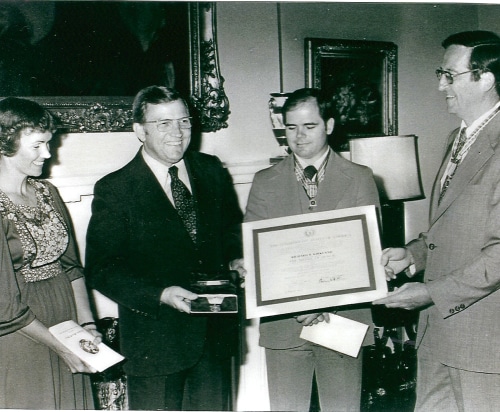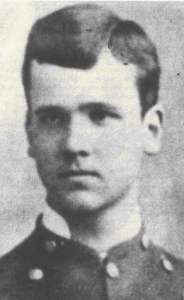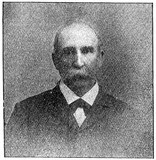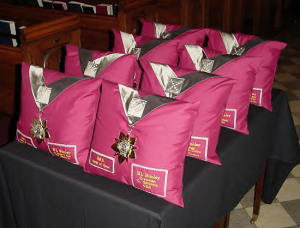
Sons of Confederate Veterans Medal Of Honor - South Carolina Division
Richard Rowland Kirkland
Wade Hampton, III
William Alexander McQueen
Raphael Painpare
Charles H. Jones
Adam W. Ballenger
The award is given to the individual who distinguished himself by conspicuous gallantry and intrepidity at the risk of life above and beyond the call of duty while engaged in action against the enemy of
Honored Recipients
Lieutenant Richard Rowland Kirkland
Tell Pa I died right, I died at my post.
The 16th SC Regiment Camp 36 of Greenville sponsored Lieutenant Kirkland for the Medal of Honor. The medal was presented to Governor James Edwards by State Commander John A. Morrow and the Commander of the 16th Regiment Camp, John S. Taylor, Jr. The pre- sentation took place at the governor’s mansion on August 17, 1977. The medal was to be permanently displayed at the governor’s mansion but it was later removed to the SC State Capitol and put on display under a large painting unveiled in 1984 of Lieutenant Kirkland giving water to the wounded soldiers.
Presented to Mrs. H. J. Haglier of Camden, South Carolina for the heroism of her ancestor Lieutenant RICHARD KIRKLAND presentation at the South Carolina Governor’s Mansion, Columbia, South Carolina, August 17, 1977.
Division Commander Robert L. Brown nominated and General P. G. T. Beauregard Camp 1458 sponsored the Medal of Honor for Lieutenant McQueen. The presentation ceremony was held November 17, 1991 at the Sumter County Museum in Sumter, where the Medal is on permanent display in the War Room honoring Sumter’s military. The ceremony was covered by the Sumter Item Newspaper and TV Channel 15 News of Florence.

Lieutenant William Alexander McQueen
Wade Hampton, III
Lieutenant General Wade Hampton, III, born in Charleston on March 28, 1818 and died in Columbia on April 11, 1902. Twenty thousand mourn- ers followed his casket to Trinity Episcopal Churchyard where he is buried.
The Confederate Medal of Honor was awarded to General Wade Hampton’s great-grand- son and great grand daughter, Wade Hampton Oliver and Mary Hampton King. The service was held September 27, 1992 at 3:00 pm at the Confederate Relic Room in Columbia, where it is on display. Real Son Ernest Eugene McAlhaney presented the medal to the family, the family then presented it to the Relic Room.
The Medal of Honor for Lieutenant General Wade Hampton, III, was nominated and sponsored by the General Wade Hampton Camp in Columbia, SC.

“God bless all my people black and white.”
General Hampton offered to enlist as a private, however, Governor Pickens of South Carolina secured him a Colonel’s commission. Colonel Hampton organized the “Hampton’s Legion” with his own money. Hampton paid for six Blakely Cannons and 400 Enfield Rifles for his legion.
During the war General Hampton would be wounded five times. His brother and his youngest son were both killed in the war. Another of his sons was wounded. General Hampton was first wounded in the head at the Battle of First Manas- sas while leading a charge.
At the Battle of Gettysburg, General Hampton received a saber wound to the head on the second day of battle, but this did not stop him. On the third day of battle, (July 3, 1863) Hampton killed three of the enemy with his revolver and another with his sword. Hampton then saw one of his men battling alone and surrounded. Hampton, then by himself, charged to aid his fellow soldier. Hampton knocked one of the enemy from the saddle. Hampton received a second saber wound that fractured his skull but refused to leave the soldier. While continuing to defend the soldier and himself General Hampton killed several of the enemy in personal combat, cleaving one man’s skull to his chin with a single stroke. Hampton had also received a wound to his side.
Raphael Painpare
First Lieutenant Raphael Painpare, Beauregard’s Artillery – Louisiana, was killed at the Battle of “Dingle’s Mill,” Sumter, SC on April 9, 1865. Lieutenant Painpare was on leave in the Sumter area recovering from a serious illness, when scouts reported that some 2600 enemy troops were advancing on Sumter. Lieutenant Painpare volunteered to command one of two cannons with a Southern force of 154 defenders of old men, teenage boys and local militia. Some of the locals believed it to be hopeless. Lieutenant Painpare stepped up and told them
“men your home is in Sumter. My home is in Louisiana, and I propose to fight my gun if anyone will help me.”
The battle began with fire on the enemy. One of the two guns was lost early. Lieutenant Painpare and the local defenders fought the enemy to a standstill. After two enemy regiments flanked the defenders, Lieutenant Painpare ordered his men to take cover, as Lieutenant Painpare alone remained at his gun, firing on the enemy. Despite a federal officer’s call to “spare that man, don’t fire at him, for he is too brave to die,” Lieutenant Painpare was mortally wounded by a volley directed at him. He is buried in Sumter, SC.
The Medal of Honor for Lieutenant Painpare was sponsored by the General PGT Beauregard Camp in Sumter, SC. The service was held April 6, 1997 at 3:00 pm at the “Battle of Dingle’s Mill” historical site. Real Son Rembert Kennedy, along with 160 others, were present for the medal service. Lieutenant Painpare’s Medal of Honor is on display at the Sumter Genealogical Research and Historical Center.
Adam W. Ballenger
Sergeant Adam W. Ballenger, was born January 17, 1844 and died December 18, 1912. He was a member of Company C, 13th SC Infantry. During the Battle of “Deep Bottom Run” fought north of the James River in Virginia on July 28, 1864, Sgt. Ballenger
“single-handedly captured an enemy artillery piece.”
The Medal of Honor service was held at Sgt. Ballenger’s grave site on September 30, 1995 at the Inman Baptist Church in Inman, SC. Over 200 people attended the service. Over one hundred of them were descendants of Sgt. Ballenger. Many of them still live in the Inman area. Others came from Alabama, Kentucky, Oregon and Texas. A grandson, Mr. Baxter Morgan Haynes, was one of the speakers. He gave some reminiscences of Sgt. Ballenger, as Mr. Haynes clearly remembered his grandfather.
Sgt. Ballenger was nominated for the medal in 1991 by the Brigadier General Stand Watie Camp 1303 in Oklahoma City, OK. The Medal of Honor service was sponsored by the Sergeant Adam W. Ballenger Camp in Spartanburg, SC. The Medal is on display at the Spartanburg Regional Museum.
Lieutenant Charles H. Jones
Lieutenant Charles H. Jones, was born in Clarendon County, SC in 1833. He died in Sumter in 1895 and is buried in the Sumter City Cemetery. Lieutenant Jones served as a member of Company I, 7th South Carolina Cavalry.
Lieutenant Jones, while leading a small scouting mission around Manning, SC, found himself and his unit cut off by yankee cavalry. While attempting to escape into the Pocotaligo Swamp, one of the young Confederates was thrown by his horse. Lieutenant Jones immediately turned back to defend his young scout. Lieutenant Jones
“single handedly drove the enemy cavalry from the field, and not one of the scouts were captured, wounded or killed!”
Lieutenant Jones stood in the middle of the road, drawing the yankee fire while urging his men on to the safety of the nearby swamp. After his men were safe, Lieutenant Jones made his escape but not before stopping a second time by himself, turning to face the enemy, pistols drawn and challenged the yankees to follow. The yankee cavalry then turned and retreated. The enemy was so enraged that they put a price on Lieutenant Jones’ head. Lieutenant Jones survived the war and became sheriff of Sumter County for several years.
The Medal of Honor service was held on December 4, 1999 at the Manning Archives in Manning, SC. There were approximately thirty people present. The Medal of Honor was presented to Lieutenant Jones’ granddaughter and is on display at the Manning Archives. The Medal of Honor for Lieutenant Jones was sponsored by the General P.G.T. Beauregard Camp of Sumter, SC.
Crew of the Submarine H L Hunley
Lieutenant George E. Dixon
James A. Wicks
J. Miller
Corporal J. F. Carlsen
Frank G. Collins
C. Lumpkin
Arnold Becker
Joseph F. Ridgaway
Joseph Banks Lyle
The newly designed medal is struck from silver and bronze with a gray neck ribbon. The Great Seal of the Confederacy rests on top of the Confederate Cross of Honor. Inscribed on each end of the cross are the words Honor, Duty, Devotion, and Valor. The cross rests upon a single star that signifies each individual state of the Confederacy. Each branch of military service is represented on each point of the star. Behind all of this is a starburst, which signifies the importance of the medal. The neck ribbon is gray silk with a square of the same material sewn onto the ribbon with thirteen stars embroidered in the shape of the St. Andrews Cross to represent the Battle Flag. Designed by passed Army Of Northern Virginia Commander Henry Kidd.

Third Crew of the Confederate Submarine “H. L. Hunley” – Eight Men
“The original citation was written in late 1990 – early 1991, nine to ten years before the Hunley submarine was recovered. At which time all names were not known, J. Miller not being listed and C. Lumpkin listed as C. Simpkins. I made these two corrections here.”
Original Citation
“Attack of the CSS H. L. Hunley on the USS Housatonic
Outside Charleston Harbor, South Carolina
17 February 1864”
“With full confidence in the Hunley’s value as an attack submarine capable of breaking the enemy blockade, Lieutenant Dixon persuaded the Commander-in-Chief to rescind a directive banning further use of the vessel. Despite the tragic loss of two previous crews and the prevailing opinion that service aboard the Hunley courted death, Corporal C. F. Carlsen of the German Artillery and five seamen from the CSS Indian Chief – Becker, Collins, Ridgeway, Lumpkin, Wicks and Pvt. Miller-volunteered for duty aboard the vessel. Under Lieutenant Dixon’s exhaustive training, the crew became proficient in the submarine’s operation, yet found that protective measures by the enemy-night lights and chain booms-and the prevailing winds and bad weather, thwarted their plans. Finally, abandoning the relative calm waters of Charleston Harbor for the hazards of the open sea, Dixon and his crew – under cover of night with nothing to guide them but ship lights and dead reckoning – surprised, attacked, and sank the USS Housatonic with an improvised torpedo as the warship lay anchored more than two miles off shore. Despite sending a signal notifying shore batteries of their return, the crew of the Hunley was never seen again. Their mysterious fate remains an ironic twist to their enduring triumph as the world’s first submariners.”
In 1995 the Hunley was located, and recovered in 2000. In 2004 the eight man crew was laid to rest with the first two crews of the CSS H. L. Hunley submarine in Magnolia Cemetery, Charleston, South Carolina.
The third crew of the H.L. Hunley has received the medal twice. The first on March 3, 1991 when a single medal was awarded to them. This was the early design and is on display at the Museum of Mobile, in Alabama. They were sponsored by the Raphael Semmes Camp 11, Sons of Confederate Veterans in Mobile. Then, on August 3, 2000, in Charleston, SC, the eight crewmen of the Confederate submarine H. L. Hunley received the first eight of the newly designed medals. These medals are numbered and Lieutenant Dixon received number one. These eight medals are now on display at the Warren Lasch Conservation Center, where the Hunley submarine is housed, in North Charleston, SC. This was just days before the Hunley submarine was raised from the bottom of Charleston harbor. The presenter of these medals was the highest decorated living veteran in America, Rear Admiral Eugene Fluckey. Having received four Navy Crosses and the Congressional Medal of Honor himself for his actions on board the WWII submarine USS Barb, Admiral Fluckey was humbled to present the crew of the first submarine in history to sink an enemy vessel during time of war with their Confederate Medals of Honor.
Captain Joseph Banks Lyle
Captain Joseph Banks Lyle, was born December 6, 1829 at Old Yonguesville near Winnsboro, South Carolina. He died August. 16, 1913 in Caddo, Oklahoma, and is buried in: Gethsemane Cemetery, Caddo. A member of the 5th South Carolina Infantry, C.S.A. He lived in Caddo the last sixteen years of his life.
“Battle Of Williamsburg Road, Virginia – October 27, 1864.”
“Seeing that the enemy attack upon the works had failed, Captain Lyle watched the foe retreat to the safety of a ravine in the middle of the battlefield. Suspecting these men to be broken in morale and dispirited, Captain Lyle, ignoring two slight wounds received earlier in the day, requested permission to advance the skirmish line and capture them, knowing they would escape under cover of approaching night. When his request was refused, Captain Lyle advanced toward the enemy position alone. Although joined by two compatriots moments later, Captain Lyle realized the danger his two companions risked in accompanying him. Instructing them to halt on a rise overlooking the enemy, he continued forward. Upon hearing the shout of an enemy officer exhorting his men to continue the fight, Captain Lyle ordered his two companions to shoot down the officer unless he stopped his tirade. Advancing alone, Captain Lyle now came under friendly fire from Confederates far up the works who mistook him for a deserter. When word spread that the distant figure was a Confederate officer, all firing ceased and men up and down the line watched in disbelief as Captain Lyle audaciously ordered the entire force before him to surrender.

After half the enemy had filed from the protection of the ravine, another officer challenged him by berating his fellow soldiers for surrendering to a single man whom they could easily overpower and kill. Grabbing a discarded Spencer carbine, Captain Lyle advanced upon the man and threatened to kill him if he did not obey his demand to surrender, dramatically ending any further resistance. In one of the most incredible feats of personal valor witnessed during the War Between the States, Captain Lyle single-handedly captured three stands of colors, several swords and small arms, and between 500 and 600 prisoners. For extraordinary heroism at great personal peril, Captain Joseph Banks Lyle is hereby awarded the Confederate Medal of Honor.”
The service was held 23 July 2003 at 3:00 at the Fairfield County Museum, in Winnsboro, SC, where the medal is on permanent display. The Medal of Honor for Captain Joseph Banks Lyle, was nominated and sponsored by the General Robert E. Lee Camp #1589 Midlothian, Virginia.

Compiled and Updated byDennis E. Todd
Historian, South Carolina Division, SCV
July 2010
















